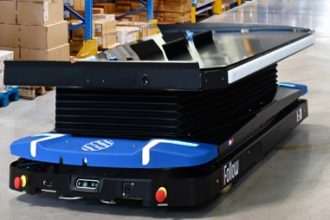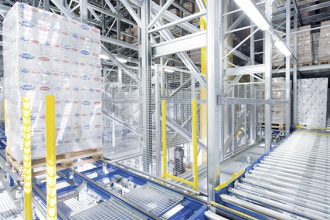Mobile Autonomous Vehicles: Comparing On-Premise To Cloud-Based Hosting Options

When investing in a mobile autonomous vehicle (MAV) system — such as a fleet of automatic guided vehicles (AGVs) or autonomous mobile robots (AMRs) — warehouse operators increasingly have the choice of hosting the fleet management, monitoring, analytics, and control software either on-premise or in the cloud. Both are viable options, according to an educational session presented by the Mobile Automation Group of MHI. The 30-minute presentation, entitled “Is Using Cloud-Based Automation Right For Your Autonomous Vehicle Systems?” explains cloud-based computing and its application to warehouse automation, as well as shares key considerations when evaluating which hosting approach is the optimal choice for a given operation.
What Is Cloud Computing?
The session first explains cloud computing. Details include its development from individual desktop computers running their own applications independently of other machines; to a network of multiple local computers connected to one or more servers on which applications are hosted and files are easily shared locally; and, finally, to Internet-connected remote servers managed by third-party computing service providers.
While the first two scenarios involve initial capital expenditures plus internal maintenance and management of the hardware and software, cloud-based services are operational expenses. Cloud computing service providers typically charge customers for a given amount of server space that can be scaled up and down as necessary, allowing the user to only pay for what is needed. Additionally, the maintenance and management of the cloud infrastructure is handled by the service provider.
Hosting Options for MAVs
As warehouses have evolved from manual operations to automated equipment — and now to greater connectivity of people and machines enabled by Industry 4.0 technologies such as the Internet of Things (IoT) — the degree of computing power required has increased exponentially. For AGVs, AMRs and other MAVs specifically, what previously could be categorized as electronic control of the systems has evolved to require higher level computation. This is needed to enable inter-fleet connectivity and communication, safe navigation, optimized fleet management, condition monitoring, and analytics.
Today’s MAVs themselves are highly computerized, often possessing more computational power than the typical laptop or desktop computer. Their on-board systems are primarily safety related, supporting real-time, autonomous navigation throughout a facility, as well as collision avoidance functions. However, when it comes to fleet management, system monitoring and analytics of the vehicles — plus integrating the equipment with other warehouse information systems — owners and operators have the choice of hosting these functions either with on-premise servers or remote, cloud-based servers.
Considerations for Evaluating On-Premise Versus Cloud-Based Hosting
When making the decision between hosting the MAVs’ control and management functions on-site or in the cloud, there are several aspects to consider. These include:
- How good is the software / network? The basic functionality (fleet management, monitoring, and analytics) will only be as good as the software and network connections, regardless of where it resides. It is important to understand the capabilities and requirements of the software and the stability and continuity of both hosting options.
- Who owns and maintains the computers? In an on-premise hosting situation, the user is responsible for the investment, as well as for maintaining the equipment and ensuring its reliability and connectivity. This may or may not require the involvement of an information technology (IT) team. In a cloud-based hosting scenario, either the cloud services provider or the equipment supplier may be responsible for the servers.
- How will the investment be allocated? If a decision is made to host on-premise, budget for both the capital expense of the initial investment and operational expenses associated with IT maintaining the system will need to be allotted. In the case of a cloud-based service, a monthly or annual fee will be charged by the service provider, similar to a lease of computational space.
- How long does it take to implement changes? If the decision is made to scale the fleet of MAVs up or down — or if updates or other system modifications are needed — it may take longer for an internal IT team to attend to those tasks, depending on their existing workload. Such modifications may be made more quickly by the equipment supplier via cloud-based hosting system.
- How much control does your operation prefer? Some companies choose on-premise hosting out of concerns for security and a desire to control and maintain backups of their own data should a disaster recovery need arise. Others feel that managing these technologies is outside their staffing capabilities or prefer to dedicate their resources to core competencies.
Need more help sorting out the hosting options? Companies considering an investment in MAVs are welcome to connect with the members of MHI’s Mobile Automation Group (MAG) for additional insights and guidance when evaluating on-premise or cloud-based hosting. Additionally, the group offers a variety of resources for those who wish to learn more about this technology — including case studies, white papers, cost estimating guidance and more — on its website, mhi.org/mag.



